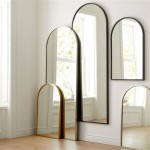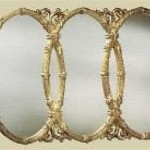Do You Have To Use A Special Mirror For Bathroom?
The question of whether a special mirror is required for bathroom use is a common one, driven by concerns about longevity and performance in a humid environment. While any mirror *can* be installed in a bathroom, certain types are significantly better suited for the conditions and will offer a more durable and satisfying user experience. The susceptibility of standard mirrors to moisture damage necessitates careful consideration of the mirror's construction and materials when selecting one for bathroom applications.
Mirrors are fundamentally constructed with three primary layers: a glass substrate, a reflective coating (usually silver or aluminum), and a protective backing. It is the interaction of moisture with these layers, particularly the reflective coating and backing, that determines a mirror's suitability for use in a bathroom. Ordinary mirrors, without specific treatments or higher-quality materials, are prone to degradation in humid environments, leading to issues such as black spots, desilvering, and overall cloudiness.
The primary concern in a bathroom environment is the elevated humidity levels resulting from showering, bathing, and general water usage. This humidity can penetrate the protective backing of a standard mirror, leading to oxidation and corrosion of the reflective layer. Over time, this process causes the silver or aluminum to break down, resulting in the unsightly black spots and a diminished reflective quality. This degradation significantly shortens the lifespan of the mirror and compromises its functionality.
Therefore, while a standard mirror *can* be used, the more pertinent question is whether it *should* be. The answer largely depends on the user’s expectations regarding the mirror's lifespan, the aesthetic considerations, and the overall bathroom ventilation. A poorly ventilated bathroom will exacerbate the effects of moisture, making a specialized mirror a more prudent investment. Conversely, a well-ventilated bathroom might allow a standard mirror to survive for a reasonable period, albeit likely not as long as a moisture-resistant alternative.
Understanding Moisture-Resistant Mirrors
Moisture-resistant mirrors are designed and manufactured to withstand the harsh conditions present in bathrooms. These mirrors incorporate various techniques and materials to minimize the ingress of moisture and protect the reflective layer from corrosion. Key features of moisture-resistant mirrors often include a thicker or more robust protective backing, specialized coatings, and higher-quality glass.
A common approach is the use of multiple layers of backing paint, which provide a more impermeable barrier against moisture. These paints are often formulated with additives that further enhance their water-resistant properties. Some manufacturers also use a sealing compound around the edges of the mirror to prevent moisture from seeping in through the sides, where the glass and backing meet. This edge sealing is particularly important in frameless mirrors, where the edges are directly exposed to the environment.
Another technique involves using a silvering process that is more resistant to corrosion. This may involve using a thicker layer of silver or incorporating other metals into the silver alloy to enhance its durability. Some mirrors utilize an aluminum reflective layer instead of silver. Aluminum is naturally more resistant to oxidation than silver, making it a viable alternative for bathroom environments. However, aluminum mirrors may not offer the same level of reflectivity as silver mirrors.
Furthermore, some moisture-resistant mirrors employ a copper-free manufacturing process. Copper is sometimes used as a primer layer beneath the silver reflective layer. However, copper is susceptible to corrosion, and its presence can accelerate the degradation of the mirror in humid environments. By eliminating copper from the manufacturing process, manufacturers can create a more durable and longer-lasting mirror for bathroom applications.
Tempered glass is another feature that can enhance the suitability of a mirror for bathroom use. While not directly related to moisture resistance, tempered glass is significantly stronger than standard glass, making it less likely to break due to accidental impacts or temperature fluctuations, which are common in bathrooms. The enhanced safety of tempered glass is a valuable consideration, particularly in bathrooms used by children or individuals with mobility issues.
Evaluating Bathroom Ventilation
The effectiveness of bathroom ventilation plays a crucial role in determining the longevity of any mirror, regardless of its construction. Adequate ventilation reduces the amount of moisture that accumulates in the bathroom, thereby minimizing the stress on the mirror's protective layers. A well-ventilated bathroom can significantly extend the life of both standard and moisture-resistant mirrors.
Bathroom ventilation is typically achieved through the use of an exhaust fan. The fan should be appropriately sized for the bathroom's square footage and should be used regularly during and after showering or bathing. The Home Ventilating Institute (HVI) provides guidelines for determining the appropriate fan size based on the bathroom's dimensions and fixture count.
In addition to an exhaust fan, natural ventilation can also contribute to reducing moisture levels. Opening a window after showering or bathing can help to dissipate humidity. However, natural ventilation is often less effective than a dedicated exhaust fan, particularly in bathrooms that lack windows or are poorly ventilated.
Other factors that can impact humidity levels in a bathroom include the frequency and duration of showers, the water temperature, and the number of people using the bathroom. Taking shorter showers, using cooler water temperatures, and ensuring that the bathroom is not overcrowded can all help to reduce humidity and prolong the lifespan of the mirror.
Regular cleaning of the bathroom can also help to prevent moisture buildup. Wiping down surfaces after showering can remove excess water and prevent it from evaporating and contributing to humidity levels. Paying particular attention to the mirror itself, and wiping away any water droplets, will help to prevent water from seeping into the edges or imperfections in the backing.
Cost vs. Longevity: Making an Informed Decision
The decision of whether to invest in a special moisture-resistant mirror often hinges on a cost-benefit analysis. Standard mirrors are generally less expensive upfront, but they may require more frequent replacement due to moisture damage. Moisture-resistant mirrors, while more costly initially, can offer a longer lifespan and ultimately prove to be a more economical choice in the long run.
When comparing the cost of different mirror types, it is important to consider the overall cost of ownership. This includes the initial purchase price, the cost of installation, and the potential cost of replacement. A standard mirror might seem like a bargain initially, but if it needs to be replaced every few years, the cumulative cost can quickly exceed that of a more durable moisture-resistant mirror.
Furthermore, the inconvenience and disruption associated with replacing a mirror should also be factored into the equation. Replacing a mirror can be a time-consuming and messy process, requiring specialized tools and skills. A longer-lasting mirror eliminates the need for frequent replacements, saving time and effort. The aesthetic considerations should also be weighed. A degraded mirror with black spots not only reflects poorly but detracts from the overall look of the bathroom.
The specific characteristics of the bathroom environment should also be taken into account. In a poorly ventilated bathroom, a moisture-resistant mirror is almost certainly a worthwhile investment. In a well-ventilated bathroom, a standard mirror might suffice, but a moisture-resistant mirror will still provide added insurance against moisture damage.
Ultimately, the decision of whether to use a special mirror for a bathroom is a personal one, based on individual needs, preferences, and budget. By carefully considering the factors discussed above, users can make an informed decision that balances cost, longevity, and aesthetic considerations.

Whats The Best Bathroom Mirror To Go For Baths

How To Frame Out That Builder Basic Bathroom Mirror For 20 Or Less

Nordic Special Shape Bathroom Mirror Simple American Retro Entrance Wall Decorative China Glass Made In Com

Bathroom And Toilet Mirror Give A New Special Look Al Khinji Group

Irregular Special Led Mirror Smart For Bathroom Defogger Hotel Home Villa China Hanging Wall Made In Com

Bathroom Mirror Special Shape Irregular Pencil Edge Myhomeware

Artforma Backlit Led Bathroom Mirror L193

Irregular Special Led Mirror Smart For Bathroom Defogger Hotel Home Villa China Hanging Wall Made In Com

Top Light Inlight Crystal Mirror Available In Special Sizes And Custom Made

Led Mirror Special Shape Motion Sensor Auto On Myhomeware








